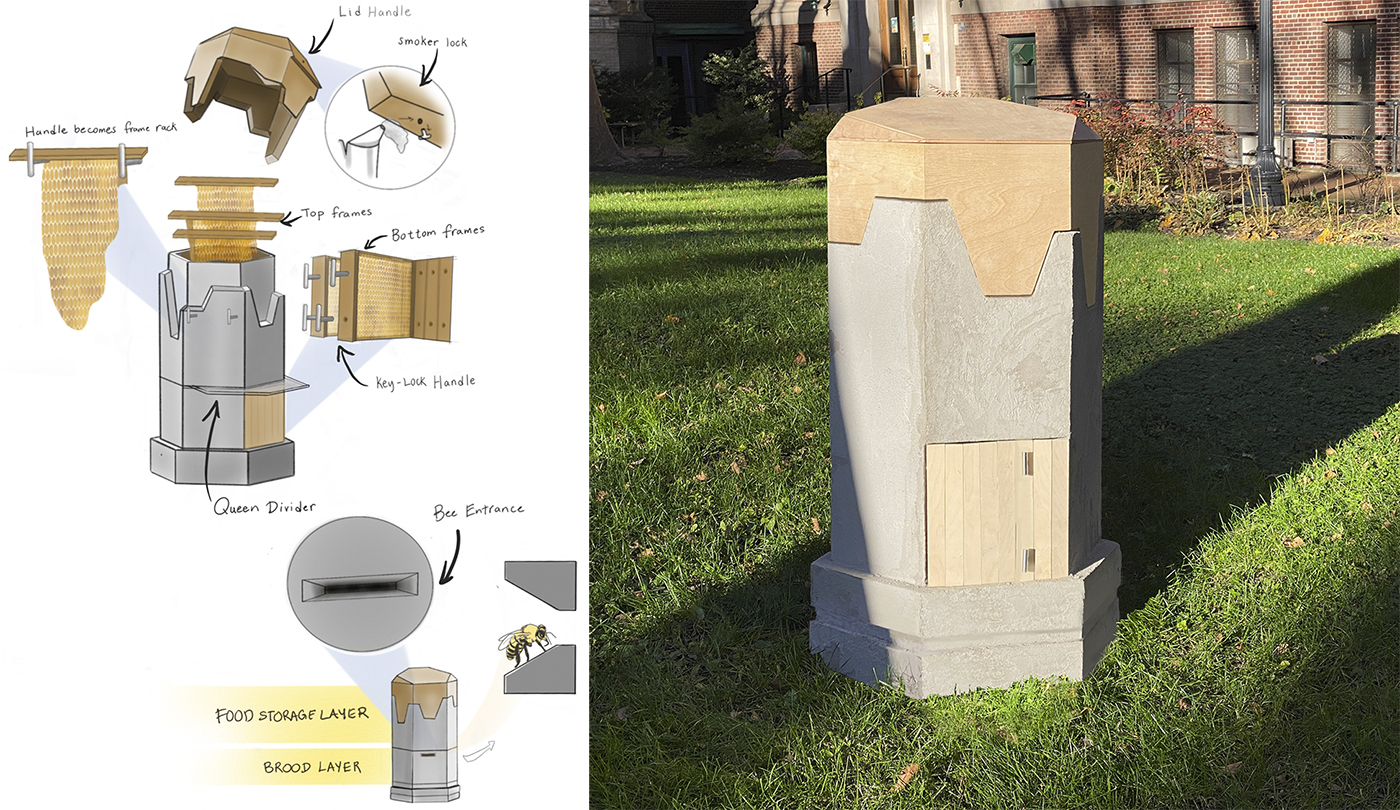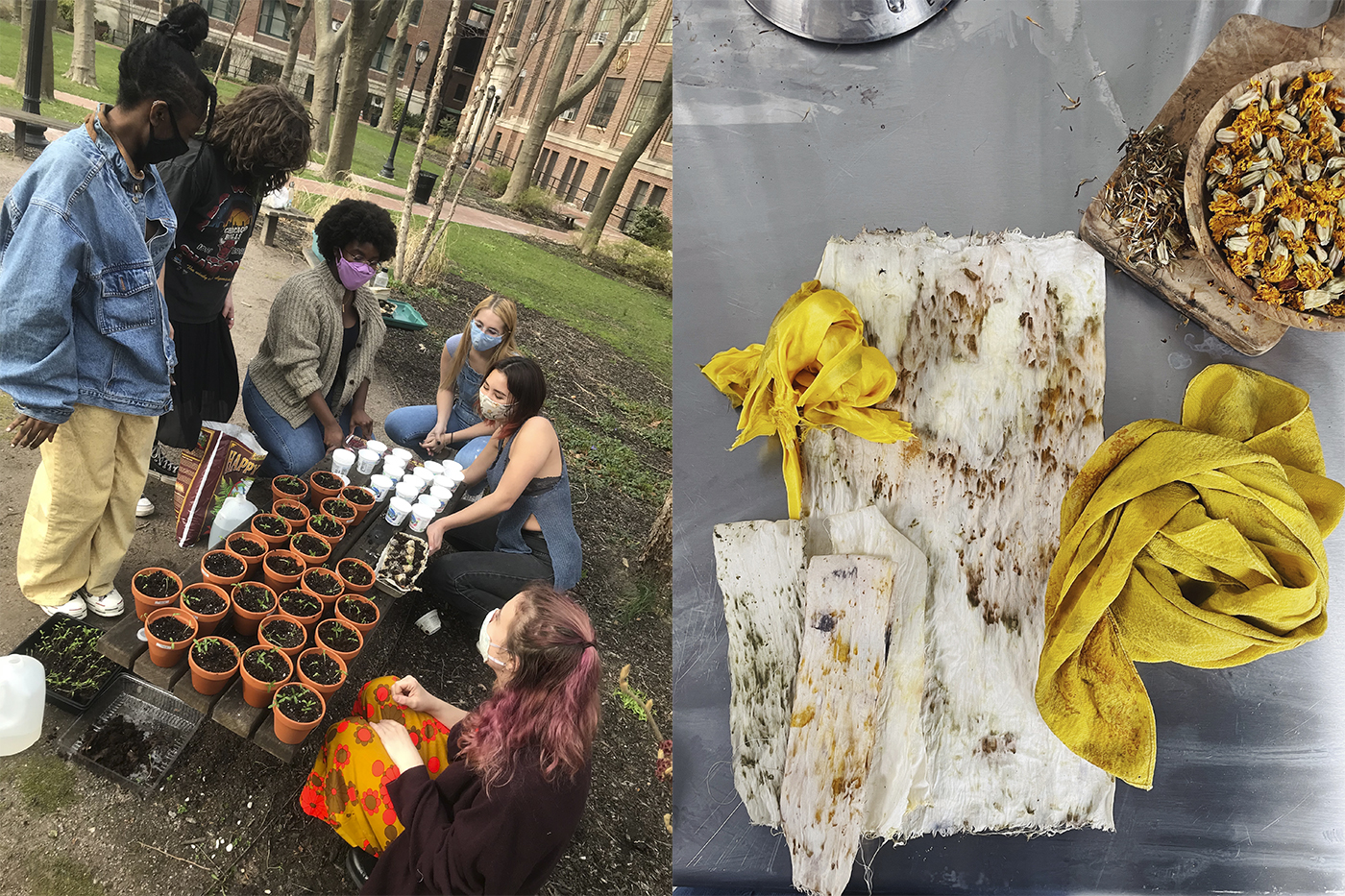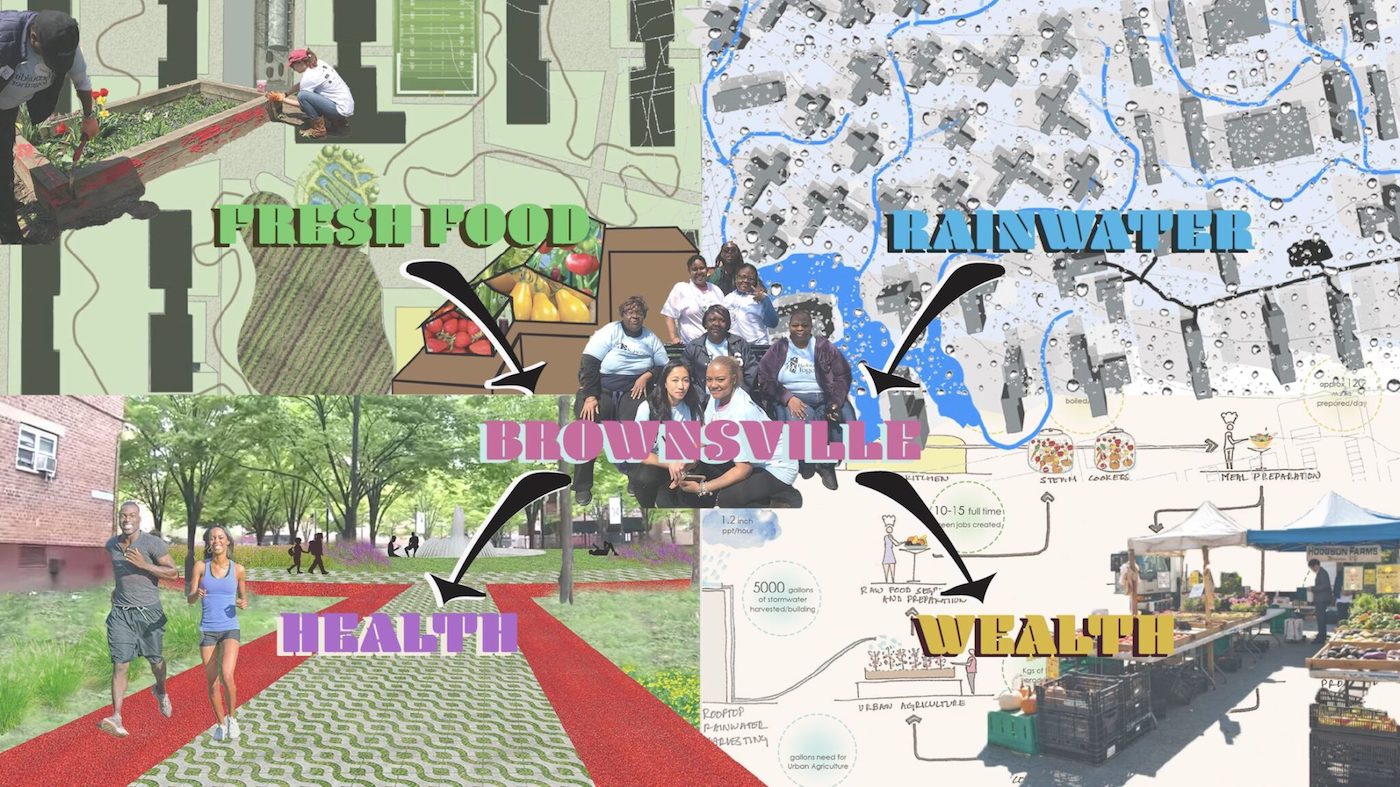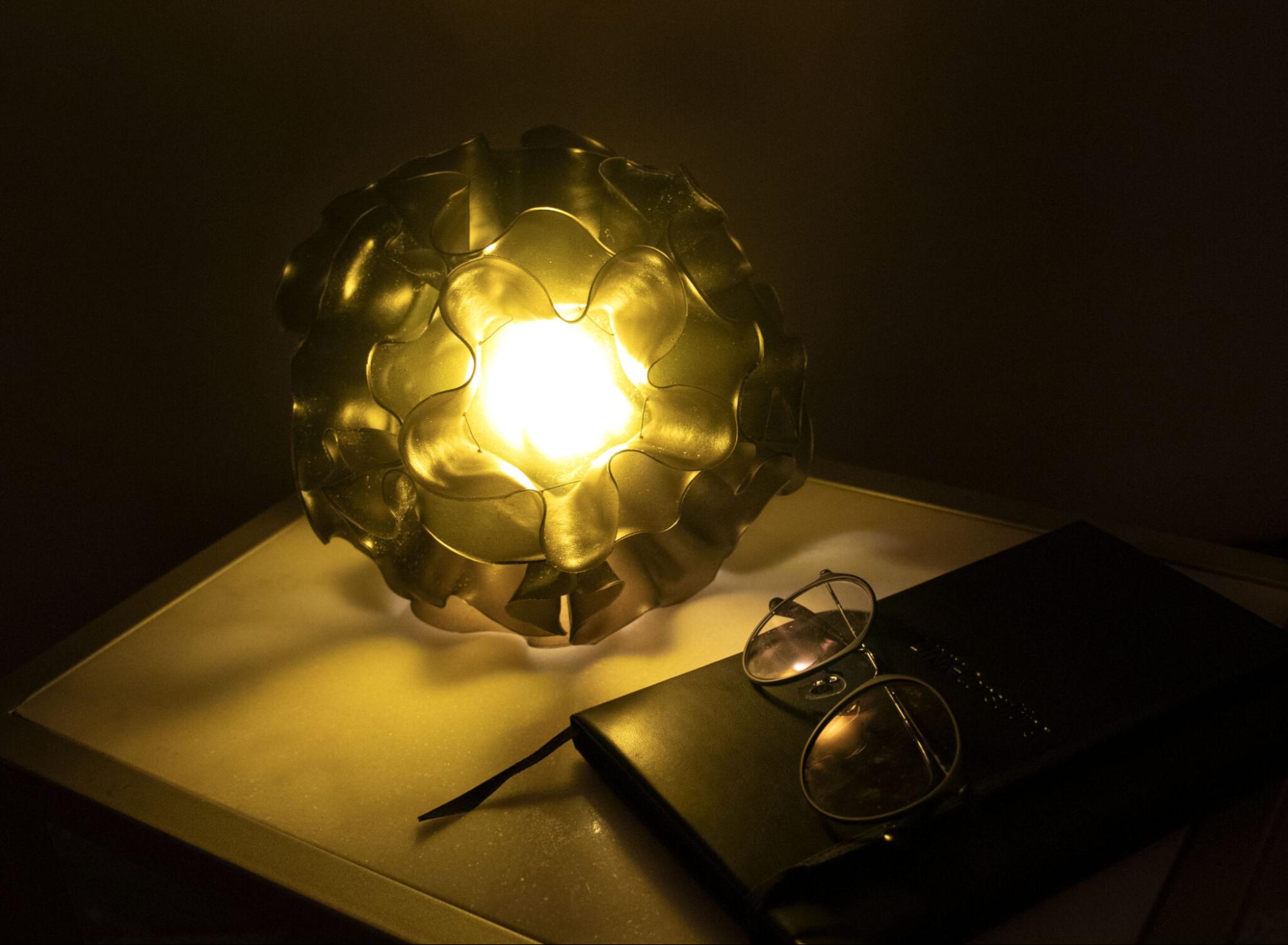Spring 2021 Pratt Earth Action Week convened in early April with virtual conversations, workshops, exhibitions, and more around the theme of “Recover, Renew, Reconnect.” Organized by the Pratt Sustainability Center and Pratt Sustainability Coalition, it followed the Fall 2020 Pratt Earth Action Week as the second edition of the twice-yearly event which was formerly Blue Week and Green Week.

The “BeeLong Beehive” by industrial design students Dawn Zeng and Audrey Ji, part of the Spring 2021 Pratt Earth Action Week Student Work Exhibit
Spring 2021 Pratt Earth Action Week convened in early April with virtual conversations, workshops, exhibitions, and more around the theme of “Recover, Renew, Reconnect.” Organized by the Pratt Sustainability Center and Pratt Sustainability Coalition, it followed the Fall 2020 Pratt Earth Action Week as the second edition of the twice-yearly event which was formerly Blue Week and Green Week.
“Green Week had been around since 2005 at Pratt and Blue Week was introduced as a counterpart in 2016,” said Tetsu Ohara, adjunct associate professor of interior design and a Pratt Earth Action Week coordinator. He explained that last year, the Pratt Sustainability Center with the Departmental Sustainability Coordinators and Pratt Sustainability Coalition decided to unite Blue and Greek Week as one biannual event. “Earth Action Week calls attention to ‘Earth’ as one without color-coding or separation and ‘Action’ as in something that we can actively engage,” Ohara said.
Ohara’s fellow Pratt Earth Action Week coordinators included Carolyn Shafer, director of sustainability for academic affairs; Tessa Maffucci, visiting instructor of fashion design; Eric O’Toole, associate professor of graduate communications/package design; and Leonel Ponce, acting academic coordinator of sustainable environmental systems in the Graduate Center for Planning and the Environment (GCPE).
That “action” element was central to the week’s events which showcased how across campus and schools there are initiatives and projects developing new approaches and solutions for sustainability, climate change, inequities in industry, and other issues. The focus was on the ongoing and intersecting crises of climate change and the COVID-19 pandemic in the context of systemic inequalities. For instance, the keynote was from Dr. Anita Bakshi of Rutgers University who has been working with the Ramapough Lunaape Turtle Clan to investigate the ongoing contamination from the dumping of toxic paint sludge in mining shafts and forests by their land in Ringwood, New Jersey. Chief Vincent Mann of the Ramapough Lunaape Turtle Clan joined the talk which was hosted by the Pratt Sustainability Center and the Sustainability Coalition as part of the School of Architecture’s Spring Lecture Series, with the full recording available to watch on the School of Architecture’s YouTube channel.
Pratt Fashion presented a dialogue on “Repairing the Fashion Industry” examining pathways to build a more equitable, transparent, and accountable fashion system. The event was hosted by the student-led Sustainable Fashion Club and moderated by Professor Nurhaizatul Jamil, co-director of Pratt’s Global South Center, and included stories of success and challenges from practitioners at the forefront of this movement. A Jam Session led by the Pratt Disaster Resilience Network (PDRN) looked at the long-term impact of Hurricane Katrina and how future planning could center a more equitable recovery. Another event hosted by PDRN with Leaders in Environmental Advocacy at Pratt featured Pechakucha-style presentations from leaders at New York-based organizations who are working on green jobs as part of a just recovery.

The Sustainable Fashion Club working on the marigold garden on campus (courtesy Tessa Maffucci); their marigolds turned into dyes for coloring swatches, created with natural dyer Cara Marie Piazza (courtesy @caramariepiazza)
Other events highlighted the solutions-driven work being led by students and faculty at Pratt. A panel and workshop on the Natural Textile Garden were presented by School of Design faculty and members of the Sustainable Fashion Club. In a hands-on demonstration with natural dyer Cara Marie Piazza, students created swatches with natural dyes made from marigolds grown on campus by members of the club. The Hazel Siegel Textile Dye Garden Exploration Fund was established in 2021 by Trustee Emeritus Robert Siegel, FAIA, in memory of his late wife, Hazel Siegel, who was a visiting assistant professor of interior design and taught a “Textiles for Interiors” course for students for over a decade.

Test vessel by Silvia Lambarri Mestres, MS Package Design ’21, created from a material made of eggshells, salt, glycerol, and gelatin
The Biomaterials at Pratt event featured presentations from students, faculty, and alumni, such as Garrett Benisch, MID ’19, and Elizabeth Bridges, MFA Interior Design ’18, who co-founded Sum Studio with designs such as a waste-based planter and a facemask made of bacterial cellulose, and Silvia Lambarri Mestres, MS Package Design ’21, whose work in packaging includes face masks made from up-cycled food ingredients and vessels made from eggshells, salt, glycerol, and gelatin. Charlotte Böhning, MID ’23, and Mary Lempres, MID ’23, shared their work in exploring biomaterials such as biochar, milk-based biopolymers, and bio-based composites. Faculty members Jay Lemire and Cindie Kehlet also discussed their work with the Material Lab and the Center for Materials Science that are continually investigating new ways of creating and using materials.
Two online exhibitions further showcased forward-thinking work from across disciplines. Sustainable FDN hosted on Milanote featured work from Foundation students on sustainability, which is a crucial part of their learning process, whether it’s eliminating classroom waste or encouraging an awareness of the impact of consumption on the world. The work included visual calls to action and digital posters addressing issues like climate change, ocean plastics, and the disparities of access to clean water.

Image from “Green Infrastructure Design Build Studio: Nourishing NYCHA – Building Up Brownsville: Cultivating Community” by Graduate Center for Planning and the Environment (GCPE) students Sebright Browne, Luis Diaz, Pankti Mehta, Aishwarya Mukund, Joseph Dakota Pelly, and Kats Tamanaha
The Student Work Exhibit showcased the breadth of student work on sustainability with projects from the School of Architecture, School of Art, School of Continuing and Professional Studies (SCPS), School of Design, and School of Liberal Arts and Sciences (SLAS). The projects included students in the Graduate Center for Planning and the Environment (GCPE) considering how green infrastructure interventions such as rain gardens and permeable paths could support the health, wellness, and financial growth of NYCHA residents in Brownsville, and SCPS student Lisa Pesok exploring how to extend the life of durable cast-iron objects like teapots and pans.
Industrial design students Dawn Zeng, BID ’21, and Audrey Ji, BID ’22, designed the “BeeLong Beehive” for the Hattie Carthan Community Garden in Bedford-Stuyvesant taking into account both the needs of the bees and how a community could care for them. Ben Erickson, BArch ’21, also looked at design for New York City environments with “Heliomorphic Housing” that proposes new building forms adapting the usual shape of city blocks with sloped roofs and solar panels to promote solar energy. Ruifei Hou, BFA Interior Design ’21, designed “The Origins-Northern California Native American Cultural Center” to be both sustainable and culturally meaningful to its indigenous community, using a dead giant sequoia tree as the base structure of its center for programming and education for the Miwok tribe in the Sierra Nevada.

“Verlumina: Bioplastic Light Diffuser” by Sylvia Chen, BID ’21
Other students are investigating how to be more sustainable with the materials they use in their practices. Aryaman Giri Gundala, MID ’22, created a clock made almost completely from waste collected from 3D printing at Pratt, while Sylvia Chen, BID ’21, created a lampshade from gelatin and agar bioplastic and dyed it with chlorophyll extracted from local California grasses. Wei Chao, BFA Jewelry ’23, engaged with repurposing materials by containing a found watch inside a work responding to nostalgia and memory.
Many more student projects are available to view online along with a full recap of the Spring 2021 Pratt Earth Action Week events. The week of conversation and collaborative creation will return in fall 2021 with more ways to get engaged with sustainable and ecologically conscious thinking and making happening at Pratt.
